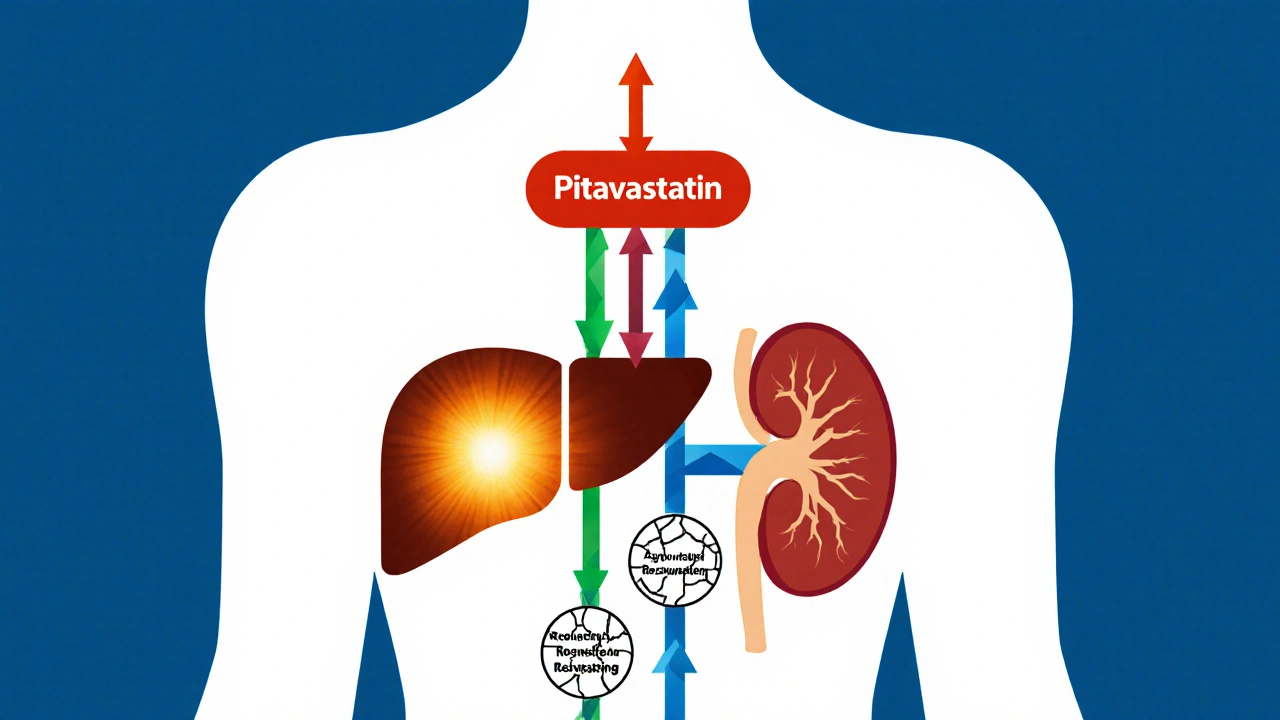Statin Diabetes Risk Comparison Calculator
Understand Your Diabetes Risk with Statins
Pitavastatin has been shown to have significantly lower diabetes risk compared to other statins like atorvastatin and rosuvastatin. This tool helps you compare your current statin to pitavastatin based on your specific health conditions.
Risk Comparison Results
Pitavastatin vs. Your Current Statin
Based on large studies including over 124,000 patients, pitavastatin has significantly lower risk of new-onset diabetes compared to atorvastatin and rosuvastatin.
Personalized Recommendation
Cost Consideration
Pitavastatin is usually covered by insurance with a $45 copay (vs. $4 for generic atorvastatin). For those with prediabetes or metabolic syndrome, the metabolic benefits may outweigh the cost difference.
When you’re on a statin to lower your cholesterol, the last thing you want is to accidentally trigger diabetes. It’s a real concern - and not all statins are the same. Among them, pitavastatin stands out. While drugs like atorvastatin and rosuvastatin have been linked to a higher chance of developing type 2 diabetes, pitavastatin shows a different pattern. For people with prediabetes, metabolic syndrome, or early insulin resistance, this difference isn’t just academic - it could change your treatment plan.
How Pitavastatin Works Differently
Pitavastatin is a third-generation statin, approved by the FDA in 2009. Like all statins, it blocks HMG-CoA reductase, the enzyme your liver uses to make cholesterol. But that’s where the similarity ends. Unlike older statins, pitavastatin doesn’t rely heavily on the liver’s CYP450 enzyme system to break down. About half of it leaves your body through the kidneys, the other half through the liver. This dual pathway means fewer drug interactions and less strain on liver metabolism.This unique metabolism might be why pitavastatin doesn’t mess with insulin the way other statins do. Studies using gold-standard tests - like the euglycemic hyperinsulinemic clamp - show that even at the highest dose (4 mg daily), pitavastatin doesn’t reduce insulin sensitivity. That’s important because insulin resistance is the first step toward type 2 diabetes. Other statins, especially high-intensity ones, can make your cells less responsive to insulin. Pitavastatin? It leaves it alone.
The Evidence: Less Diabetes Risk, More Confidence
Large studies back this up. A 2022 meta-analysis of over 124,000 patients found pitavastatin had a 18% lower risk of new-onset diabetes compared to atorvastatin and a 20% lower risk compared to rosuvastatin. The numbers don’t lie: hazard ratios were 0.82 for pitavastatin versus 1.14 and 1.18 for the others. That’s not a small difference - it’s clinically meaningful.Another analysis of nearly half a million patients in Canada showed pitavastatin users had a 12-15% lower risk of developing diabetes than those on atorvastatin or rosuvastatin. Even when compared to pravastatin - another statin known for being gentle on glucose - pitavastatin performed just as well. One study even found pitavastatin had a slightly better effect on HbA1c than pravastatin in people with HIV and dyslipidemia.
But here’s the catch: not every study agrees. A 2019 single-center study in South Korea reported the opposite - that pitavastatin had the highest risk of new diabetes among statins. But that study had limitations: small sample size, retrospective design, and no control for baseline risk factors. Most experts consider it an outlier. The bulk of the evidence - from randomized trials, population studies, and meta-analyses - consistently points to pitavastatin being one of the safest options for glucose metabolism.
Who Benefits Most?
If you’re in one of these groups, pitavastatin might be the best statin choice:- You have prediabetes (fasting glucose 100-125 mg/dL or HbA1c 5.7-6.4%)
- Your BMI is over 30
- You have high triglycerides or low HDL
- You’ve noticed your blood sugar rising since starting another statin
- You have metabolic syndrome - three or more of: waist size over 40 inches, high blood pressure, high triglycerides, low HDL, high fasting glucose
For these people, switching from atorvastatin or rosuvastatin to pitavastatin isn’t just a precaution - it’s a strategy. One cardiologist in a Reddit thread said he’d switched over 20 prediabetic patients to pitavastatin, and 17 saw their HbA1c stabilize or drop within six months. That’s not magic. It’s biology.
Even in high-risk populations like people with HIV, pitavastatin didn’t worsen insulin resistance. In fact, HbA1c rose by just 0.05% over a year - barely a blip. Compare that to other statins, where HbA1c jumps by 0.1-0.3% in the same timeframe.

What About Cost and Access?
There’s a downside: price. Brand-name LIVALO (pitavastatin) costs around $350 a month without insurance. Generic atorvastatin? Around $4. That’s a huge gap. For someone with no diabetes risk, the extra cost might not make sense. But for someone with prediabetes, the trade-off is worth it.Good news: 92% of Medicare Part D plans cover pitavastatin, usually at a tier 2 co-pay of about $45 per month. Many private insurers follow suit. If you’re on a high-deductible plan, ask your doctor for samples or check patient assistance programs from Kowa Pharmaceuticals. The cost isn’t trivial, but it’s manageable for most.
Guidelines Are Catching Up
The American College of Cardiology and the American Heart Association updated their cholesterol guidelines in 2023. For the first time, they gave pitavastatin a Class IIb recommendation - meaning it’s reasonable to choose it over other statins when moderate-intensity therapy is needed and diabetes risk is a concern. The American Diabetes Association also supports this approach, saying moderate-intensity statins like pitavastatin or pravastatin are preferred in patients with diabetes or prediabetes when LDL targets can be met.Doctors are listening. A 2023 survey of 456 cardiologists found 68% would pick pitavastatin for a patient with prediabetes, while only 13% would choose atorvastatin. That’s a clear shift in clinical thinking.

What You Should Do
If you’re on a statin and worried about your blood sugar:- Ask your doctor for a recent HbA1c and fasting glucose test. If you haven’t had one in the last 6 months, get one.
- If your HbA1c is rising - even slightly - and you’re on rosuvastatin or atorvastatin, ask if switching to pitavastatin is an option.
- Don’t stop your statin. The cardiovascular benefits of statins far outweigh the diabetes risk for most people.
- Get your glucose checked again 3 months after any switch. You might see improvement.
Even if you don’t have prediabetes now, if you have other risk factors - obesity, family history, high triglycerides - pitavastatin could be a smarter long-term choice. It’s not about avoiding statins. It’s about choosing the right one.
The Big Picture: Benefits Still Outweigh Risks
Let’s be clear: all statins slightly increase diabetes risk. But the risk of heart attack, stroke, or dying from cardiovascular disease is much higher - especially if you have high cholesterol. The FDA and EMA both say the benefits of statins far outweigh the small chance of developing diabetes.Pitavastatin doesn’t eliminate that risk. But it minimizes it. And in people who are already on the edge of diabetes, that matters. It’s not about fear. It’s about precision.
The PERISCOPE trial - a 5,200-patient study comparing pitavastatin to atorvastatin in diabetic patients - is due to report results in late 2026. If it confirms that pitavastatin protects the heart just as well as atorvastatin but with less metabolic damage, it could become the new standard for high-risk patients.
Until then, the evidence we have is strong enough to make a difference. For the right person, pitavastatin isn’t just another statin. It’s a tool to lower cholesterol without pushing you closer to diabetes.
Does pitavastatin cause diabetes?
No, pitavastatin does not cause diabetes. While all statins carry a small risk of increasing blood sugar, pitavastatin has been shown in multiple large studies to have a neutral or even favorable effect on glucose metabolism. Compared to atorvastatin and rosuvastatin, pitavastatin is associated with a significantly lower risk of new-onset diabetes - especially in people with prediabetes or metabolic syndrome.
Is pitavastatin safe for people with prediabetes?
Yes, pitavastatin is considered one of the safest statins for people with prediabetes. Studies show it doesn’t worsen insulin resistance or raise HbA1c levels, unlike higher-intensity statins. Guidelines from the American Heart Association and American Diabetes Association now suggest pitavastatin or pravastatin as preferred options for these patients when moderate cholesterol lowering is needed.
How does pitavastatin compare to atorvastatin for diabetes risk?
Pitavastatin has a much better metabolic profile. A 2022 meta-analysis found the risk of new-onset diabetes was 18% lower with pitavastatin than with atorvastatin. Atorvastatin increases insulin resistance and fasting glucose in many patients, while pitavastatin does not. For someone with prediabetes, switching from atorvastatin to pitavastatin often stabilizes or improves blood sugar levels.
What’s the best dose of pitavastatin for someone with metabolic syndrome?
The standard dose for metabolic syndrome is 2 mg to 4 mg daily. At 4 mg, pitavastatin lowers LDL cholesterol by 30-50%, which is considered moderate-intensity therapy. This dose is effective for cholesterol control without increasing diabetes risk. Higher doses (up to 8 mg) show no additional metabolic harm, but are rarely needed unless LDL targets aren’t met at 4 mg.
Should I switch from atorvastatin to pitavastatin if my blood sugar is rising?
If your HbA1c or fasting glucose has gone up since starting atorvastatin, switching to pitavastatin is a reasonable and evidence-based choice. Many doctors report seeing blood sugar levels stabilize after the switch. Always check your glucose 3 months after switching to confirm the effect. Don’t stop your statin - just change to one that’s gentler on your metabolism.
Is pitavastatin covered by insurance?
Yes, most major insurance plans, including Medicare Part D, cover pitavastatin. It’s usually listed as a tier 2 drug, meaning a co-pay of around $45 per month. The brand-name version (LIVALO) costs about $350 without insurance, but generic versions are available and more affordable. Check with your pharmacy or use GoodRx for coupons.
Are there any side effects of pitavastatin I should worry about?
Pitavastatin’s side effects are similar to other statins: muscle aches, headache, nausea. It’s less likely to cause liver enzyme elevations or drug interactions because it doesn’t rely on CYP450 enzymes. The biggest concern isn’t side effects - it’s cost. But for patients with prediabetes, the metabolic safety makes it worth the extra expense.
Will I need to take pitavastatin forever?
If you have high cholesterol and cardiovascular risk factors, long-term statin use is usually recommended. Pitavastatin isn’t a short-term fix - it’s a long-term tool for heart protection with minimal metabolic cost. Stopping it increases your risk of heart attack and stroke. The goal isn’t to stop the medication - it’s to choose the right one for your body.
What’s Next?
The PERISCOPE trial, expected to finish in late 2026, will tell us whether pitavastatin protects the heart as well as atorvastatin in diabetic patients. If it does - and the data so far suggests it will - pitavastatin could become the go-to statin for anyone with diabetes, prediabetes, or metabolic syndrome.Until then, the evidence is clear: if you’re at risk for diabetes and need a statin, pitavastatin is the smartest choice. It lowers cholesterol without pushing your blood sugar higher. That’s not just a benefit - it’s a game-changer for millions of people trying to protect both their heart and their metabolism.







Write a comment